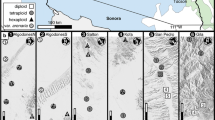Abstract
Principal components analysis of 27 morphological characters for 18 accessions of teosinte and 3 accessions of maize separated teosinte into 6 phenetic groups which showed broad agreement with previous taxonomic groupings. Tests for regression suggested significant linear relationships with altitude; teosintes from higher elevations are generally more maize-like for a combination of characters. Introgression from maize may have blurred racial identities within teosinte, but variation among current teosinte accessions cannot be satisfactorily explained solely on the basis of known maize introgression. It appears instead that racial differentiation in teosinte was well established by the time of the domestication of maize. While current racial classification of teosinte is quite useful, it does not adequately reflect the amount of genetic variation, nor does it accurately portray many of the relationships within teosinte.
Similar content being viewed by others
Literature Cited
Beadle, G. W. 1978. Teosinte and the origin of maize.In Maize Breeding and Genetics, D. B. Walden, ed. Wiley, N.Y.
Bird, R. McK. 1978. A name change for Central American teosinte. Taxon 27: 361–363.
Brewbaker, J. L. 1979. Diseases of maize in the wet lowland tropics and the collapse of the classic Maya civilization. Econ. Bot. 33: 101–118.
Galinat, W. C. 1971. The origin of maize. Annual Rev. Genet. 5: 447–478.
—. 1973. Preserve Guatemalan teosinte, a relict link in corn’s evolution. Science 180: 325.
—. 1978. The inheritance of some traits essential to maize and teosinte.In Maize Breeding and Genetics, D. B. Walden, ed. Wiley, N.Y.
— 1972. Distance analysis in biology. Syst. Zool. 21: 174–186.
—. 1978. History and origin of corn.In Melhoramento e Producão do Milho no Brasil, E. Paterniani, ed. Fundacao Cargill, Piracicaba, S.P., Brazil.
Guzman, R. M. 1978. Redescubrimiento deZea perennis (Gramineae). Phytologia 38: 177.
Hitchcock, A. S. 1922. A perennial species of teosinte. J. Wash. Acad. Sci. 12: 205–208.
Iltis, H. H., and J. F. Doebley. 1980. Taxonomy ofZea (Gramineae). II. Subspecific categories in theZea mays complex and a generic synopsis. Amer. J. Bot. 67: 994–1004.
—,———, R. M. Guzman, and B. Pazy. 1979.Zea diploperennis (Gramineae): A new teosinte from Mexico. Science 203: 186–188.
Kato Y., T. A. 1976. Cytological studies of maize (Zea mays L.) and teosinte (Zea mexicana (Schräder) Kuntze) in relation to their origin and evolution. Mass. Agric. Exp. Sta. Bull. No.635.
Lorenzo, J. L., and L. G. Quintero. 1970. El mas antiguo teosinte. Inst. Nac. Antropol. Hist. Bol. 42: 41–43.
Mangelsdorf, P. C. 1974. Corn, Its Origin, Evolution and Improvement. Harvard Univ. Press, Cambridge, MA.
Melhus, I. E., and I. M. Chamberlain. 1953. A preliminary study of teosinte in its region of origin. Iowa State Coll. J. Sci. 28: 139–164.
Randolph, L. F. 1976. Contributions of wild relatives of maize to the evolutionary history of domesticated maize: A synthesis of divergent hypotheses I. Econ. Bot. 30: 321–345.
-. n.d. Contributions of wild relatives of maize to the evolutionary history of domesticated maize. A synthesis of different hypotheses II. (In preparation).
Smith, J. S. C. 1977. Biochemical systematic studies ofZea, Tripsacum and related genera. Ph.D. thesis, Univ. Birmingham, Birmingham, U.K.
-, M. M. Goodman, and T. A. Kato Y. n.d. (a). Variation within teosinte. II. Numerical analysis of chromosome knob data. Econ. Bot.
-,-, and C. W. Stuber. n.d. (b). Variation within teosinte. III. Numerical analysis of isozyme data. (In preparation).
Timothy, D. H., C. S. Levings III, D. R. Pring, M. F. Conde, and J. L. Kermicle. 1979. Organelle DNA variation and systematic relationships in the genusZea: Teosinte. Proc. Natl. Acad. Sci. U.S.A. 76: 4220–4224.
Wellhausen, E. J., L. M. Roberts, and E. Hernandez X. 1952. Races of Maize in Mexico. Bussey Inst., Harvard Univ., Cambridge, MA.
Wilkes, H. G. 1967. Teosinte; the closest relative of maize. Bussey Inst., Harvard Univ., Cambridge, MA.
—. 1970. Teosinte introgression in the maize of the Nobogame valley. Bot. Mus. Leaft. Harvard Univ. 22: 297–311.
—. 1972. Genetic erosion in teosinte. PL Genetic Resources Newslett. 28: 3–10.
—. 1977. Hybridization of maize and teosinte in Mexico and Guatemala and the improvement of maize. Econ. Bot. 31: 254–293.
Author information
Authors and Affiliations
Rights and permissions
About this article
Cite this article
Smith, J.S.C., Goodman, M.M. & Lester, R.N. Variation within teosinte. I. Numerical analysis of morphological data. Econ Bot 35, 187–203 (1981). https://doi.org/10.1007/BF02858686
Received:
Accepted:
Issue Date:
DOI: https://doi.org/10.1007/BF02858686




